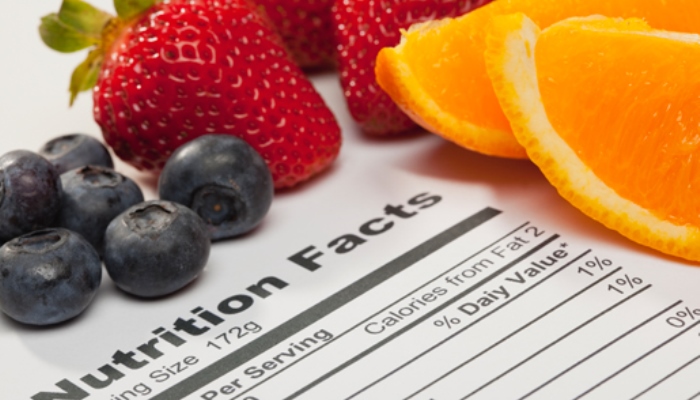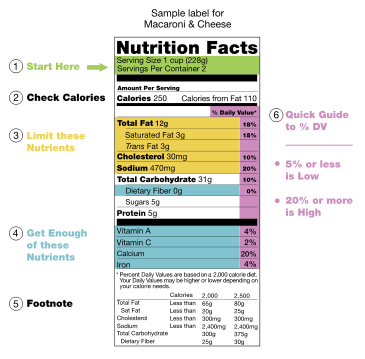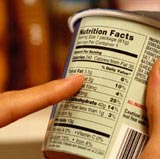
The nutrition facts label (also known as the nutrition information panel, and various other slight variations) is a label required on mostpackaged food in many countries.
Since 1994 food manufacturers have been required by the Food and Drug Administration (FDA) to include food labels (or Nutrition Facts labels) on product packaging so that consumers have accurate nutritional information about the food they purchase. But food labels are more than just a federal requirement – once you understand the information they provide, you can use food labels as a guide to planning healthier meals and snacks.
Food labels are required on almost all foods, except those that don't provide many nutrients such as coffee, alcohol and spices. Although some restaurants provide information about the food they serve, they aren't required to have labels. The FDA recommends that sellers provide nutritional information on produce, meat, poultry and seafood, but it's strictly voluntary.
Marketing and fashion interests may include other claims: "Source of Fibre", "Soluble Fiber", "Omega3", "Excellent Source of Calcium", "No preservatives", "No artificial ... ", and so on—slight varying depending on the country.
Food labels have several parts, including the front panel, Nutrition Facts, and ingredient list. The front panel often tells you if nutrients have been added—for example, "iodized salt" lets you know that iodine has been added, and "enriched pasta" (or "enriched" grain of any type) means that thiamin, riboflavin, niacin, iron, and folic acid have been added.
1 - Serving Sizes
To understand more about food labels and serving sizes, look to the sample food label on the right. At the top of the label under Nutrition Facts, you'll see the serving size and the number of servings in the package. The rest of the nutrition information in the label is based on one serving. In this example, one cup is designated as one serving, and the package contains two servings.
That means that if you eat the whole box of macaroni and cheese, you’re eating two servings, not one, so you’ll have to multiply the number of calories, fat grams and other nutrients by two to get accurate nutrition information.
2 - Check calories
This part of the label provides the calories per serving and the calories that come from fat. If you need to know the total number of calories you eat every day or the number of calories that come from fat, this section provides that information. In this example there are 250 calories in a one-cup serving of macaroni and cheese. But almost half the calories, 110, come from fat. Remember that this part of the label doesn't tell you whether you are eating saturated or unsaturated fat.
On the right side of the label, you'll see a column that lists percentages that are highlighted in purple. These percentages refer to the percent daily values (%DV). Percent daily values tell you how much of something, whether it's fat, sugar or vitamin A, one serving will give you compared to how much you need for the entire day. It will help you gauge the percentage of a nutrient requirement met by one serving of the product. One way to use this section of the label is when you comparison shop. For example, if you're concerned with sodium, you can look at two foods and choose the food with the lower % DV. Are you trying to eat a low-fat diet? Look for foods that have a lower percent daily value of fat.
Let's take the example of macaroni and cheese. Let's say one brand provides 18% DV of fat and another brand provides 25% DV of fat. A better nutritional choice may be the brand that provides 18% because you're using less of your "fat budget" for the day. But be careful to read the list of ingredients to make sure there isn't increased sodium or sugar in the macaroni and cheese with 18% DV.
The % DV is based on how much or how little of the key nutrients you should eat whether you eat 2,000 or 2,500 calories a day. So if you eat a 2,000-calorie diet, you should eat less than 65 grams of fat in all the foods you eat for the day. If you're eating 12 grams of fat in your one serving of macaroni and cheese (remember that's one cup), you can calculate how much fat you have left for the day. You can use the bottom part of the food label in white to compare what you are eating to the % DV you're allowed for that nutrient, whether it's fat, sodium or fiber. If you need more or less than 2,000 or 2,500 calories, you'll need to adjust this accordingly.
3 - Limit these nutrients
The sections on the label highlighted in yellow show the name of a nutrient and the amount of that nutrient provided by one serving of food. In our example, one serving of macaroni and cheese contains 12 grams of fat, 30 milligrams of cholesterol, 470 milligrams of sodium and 31 grams of carbohydrate. You may need to know this information, especially if you have high blood pressure, diabetes or are eating a diet that restricts certain nutrients such as sodium or carbohydrates.
Food labels also include information about how much sugar and protein is in the food. If you are following a low-sugar diet or you're monitoring your protein intake, it's easy to spot how much of those nutrients are contained in one serving.
4 - Get enough of these nutrients
The light purple part of the label lists nutrients, vitamins and minerals in the food and their percent daily values. Try to average 100% DV every day for vitamins A and C, calcium, iron and fiber. Do the opposite with fat, saturated fat, sodium and cholesterol. Try to eat less than 100% DV of these.
5 - The Footnote
Below the asterisk sign (*) at the bottom of the label, you’ll see the key nutrients listed and how much you should eat, depending on your calorie intake.
The %DV is based on how much, or how little of the key nutrients you should eat whether you eat 2,000 or 2,500 calories a day. So if you eat a 2,000 calorie diet, you should eat less than 65 g of fat in all the foods you eat for the day. If you’re eating 12g of fat in your one serving of macaroni and cheese (remember that’s 1 cup), you can calculate how much fat you have left for the day. You can use the bottom part of the food label to compare what you are eating to the %DV you’re allowed for that nutrient, whether it’s fat, sodium, fiber, etc.
6 - The Percent Daily Value (%DV)
The % Daily Values (%DVs) are based on the Daily Value recommendations for key nutrients but only for a 2,000 calorie daily diet--not 2,500 calories. You, like most people, may not know how many calories you consume in a day. But you can still use the %DV as a frame of reference whether or not you consume more or less than 2,000 calories.
The %DV helps you determine if a serving of food is high or low in a nutrient. Note: a few nutrients, like trans fat, do not have a %DV--they will be discussed later.
Do you need to know how to calculate percentages to use the %DV? No, the label (the %DV) does the math for you. It helps you interpret the numbers (grams and milligrams) by putting them all on the same scale for the day (0-100%DV). The %DV column doesn't add up vertically to 100%. Instead each nutrient is based on 100% of the daily requirements for that nutrient (for a 2,000 calorie diet). This way you can tell high from low and know which nutrients contribute a lot, or a little, to your daily recommended allowance (upper or lower).
Understanding Nutrition Labeling
In addition to requiring that packaged foods contain a Nutrition Facts label, the FDA also regulates the use of phrases and terms used on the product packaging. Here's a list of common phrases you may see on your food packaging - and what they actually mean.
No fat or fat free: Contains less than 1/2 gram of fat per serving
Lower or reduced fat: Contains at least 25 percent less per serving than the reference food. (An example might be reduced fat cream cheese, which would have at least 25 percent less fat than original cream cheese.)
Low fat: Contains less than 3 grams of fat per serving
Lite: Contains 1/3 the calories or 1/2 the fat per serving of the original version or a similar product
No calories or calorie free: Contains less than 5 calories per serving
Low calories: Contains 1/3 the calories of the original version or a similar product
Sugar free: Contains less than 1/2 gram of sugar per serving
Reduced sugar: at least 25% less sugar per serving than the reference food
No preservatives: Contains no preservatives (chemical or natural)
No preservatives added: Contains no added chemicals to preserve the product. Some of these products may contain natural preservatives
Low sodium: contains less than 140 mgs of sodium per serving
No salt or salt free: Contains less than 5 mgs of sodium per serving
High fiber: 5 g or more per serving (Foods making high-fiber claims must meet the definition for low fat, or the level of total fat must appear next to the high-fiber claim)
Good source of fiber: 2.5 g to 4.9 g. per serving
More or added fiber: Contains at least 2.5 g more per serving than the reference food
With some Nutrition-Facts practice, you'll be able to quickly scan a food label and learn how the food fits into your nutrition and diet for the day.
![]()
Disclaimer: This website is for information purposes only. By providing the information contained herein we are not diagnosing, treating, curing, mitigating, or preventing any type of disease or medical condition. Before beginning any type of natural, integrative or conventional treatment regime, it is advisible to seek the advice of a licensed healthcare professional.



























